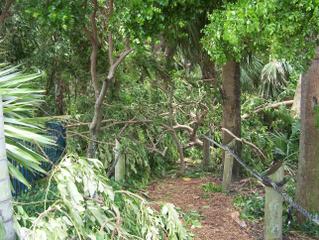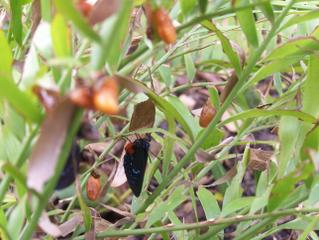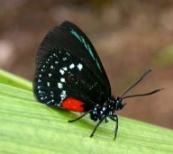Katrina's Kick

Hope that all of you are safe and sound (and with electric!) now that Hurricane Katrina has left us. The butterflies suffered some major losses; park employees and private atala fosterers are still assessing the damages. If you are able to volunteer some time at any of your local parks, whether city, county, state or national, DO SO! The clean up efforts are massive; for such a “small” Category One hurricane, Katrina sure left behind a mess. The first butterfly I usually see after a storm is nice big Sulfur, but this time it was three Ruddy Daggerwings that were the first to venture out. Then a Zebra, and THEN a Sulfur.
I haven’t yet gotten to all of the areas where we have introduced, semi-wild or managed atala populations. Everglades National Park got beat up and had some flooding, but haven't heard more than that yet. Arch Creek in Miami-Dade County took quite a beating, but there are still some atala adults managing to hang on and the coontie is OK. Chris Hernandez, a naturalist at Crandon Park, on Key Biscayne, tells me that the landscaped areas fared worse than the wild areas (isn’t that almost always true?) but that the butterflies survived surprisingly well.
However, the downtown Fort Lauderdale population got slam-dunked…. On Saturday, the 27th, there were many trees and branches down, bushes twisted and wrenched away from the soil, and of course, everything underneath got mangled badly as well. I saw three newly emerged adults hanging on tightly
 in the still-strong winds, twelve caterpillars hunkered in the smashed coontie among the rubble of downed trees and bushes, and fortunately there were a large number of intact pupae…but there were also scores of dead larvae and pupae lying in the leaf litter and debris. Most of the pupae were newly formed, just one or two days before the hurricane struck, and still had their yellow spots. Hopefully, Florida Native Plant Society, and the Broward Chapter, will be able to help replant and then I'll re-introduce the butterfly if needed.
in the still-strong winds, twelve caterpillars hunkered in the smashed coontie among the rubble of downed trees and bushes, and fortunately there were a large number of intact pupae…but there were also scores of dead larvae and pupae lying in the leaf litter and debris. Most of the pupae were newly formed, just one or two days before the hurricane struck, and still had their yellow spots. Hopefully, Florida Native Plant Society, and the Broward Chapter, will be able to help replant and then I'll re-introduce the butterfly if needed. 
East Hollywood also got punched out! The beaches are still closed with trees down everywhere. John Williams Park in West Hollywood faired a little better than the parks near the beaches, but I saw no adult atalas there. However, there were eggs and larvae indicating that adults are in the natural area somewhere. There were fewer downed branches, and no downed trees, but the coontie got flattened and again, I found numerous dead, drowned larvae underneath the fronds. Compassion wins over science for me almost always, and I moved the living ones, such as the little caterpillar shown here scrambling across the debris in Riverwalk, to safer quarters.
Most of the fosterers have called to say that they have survivors, so we are very happy for that. And we hope that you and yours are all safe. Please help in whatever way you are able...help here, help there in New Orleans...just put in a few hours or dollars somewhere to help out. When people say "Someone ought to do something..." I always answer in the words of Hillel: "If not you, who? If not now, when?"
Stay safe,
Sandy


0 Comments:
Post a Comment
<< Home